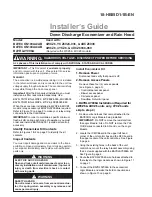
50-606 Kotron Tip Sensitive RF Level Sensor
4
1.6.2 Vertical Mounting
As medium rises on the probe, unit will signal at a point
determined by the calibration of the unit and the dielectric
constant of the medium. In conductive media, the actua-
tion point will be at the tip of the probe over a wide range
of zero calibrations. Refer to Figure 3.
1.7
Installation Instructions
1. Thread amplifier assembly into mounting bushing
on tank using suitable pipe compound or thread
tape. Assembly may also be bolted to a flange with
a suitable gasket.
2. Tighten securely, being certain that the wrench is applied
ONLY
to the mounting nut. Refer to Figure 3.
1.8
Wiring
All power and control connections are made at the termi-
nal strip within the amplifier enclosure. 16 AWG wire is
recommended for power and control circuit.
Caution:
Observe all local electrical codes and proper wiring
procedures.
1. Make sure the power source is turned off.
2. Unscrew and remove housing cover.
3. Pull power supply and control wires through
conduit connection.
4. Connect power leads to applicable AC or DC terminals as
marked. Refer to Figure 4.
5. Connect control circuit leads to relay terminals. Refer to
Figure 4. Make sure the load to be controlled is within the
relay’s rated capacity.
6. Dress wiring to guard against interference or contact with
cover or circuit board components.
7. Prevent moisture seepage into the housing by installing an
approved seal-drain fitting in the conduit run leading to
the unit.
8. Select operating mode. Refer to Section 1.8.1,
Operating
Mode Selection
on page 5 for detailed information. Make
sure that the operating mode jumper wire is in the correct
position for your selection. Refer to Figure 4.
Mounting nut
apply wrench here
Tank mounting
bushing
Actuation point in
conductive media
Figure 3
Vertical mounting
Operating
Mode
Jumper
Wire
Terminal Strip
AC Power
Supply
Connections
Control
Connections
DC Power
Supply
Connections
Zero
Adjustment
GND AC
AC
RELAY +24v
LL
CM
HL
GND
Figure 4
Terminal connections


































